Related Research Articles

The wars of Scottish Independence were a series of military campaigns fought between the Kingdom of Scotland and the Kingdom of England in the late 13th and early 14th centuries.

John Balliol or John de Balliol, known derisively as Toom Tabard, was King of Scots from 1292 to 1296. Little is known of his early life. After the death of Margaret, Maid of Norway, Scotland entered an interregnum during which several competitors for the Crown of Scotland put forward claims. Balliol was chosen from among them as the new King of Scotland by a group of selected noblemen headed by King Edward I of England.
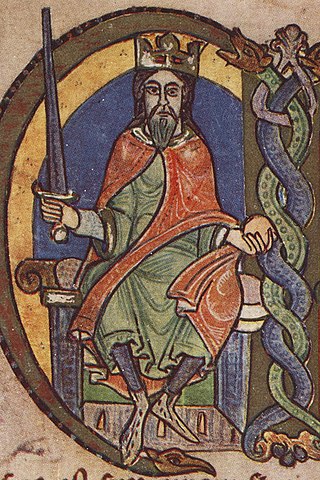
David I or Dauíd mac Maíl Choluim was a 12th-century ruler and saint who was Prince of the Cumbrians from 1113 to 1124 and later King of Scotland from 1124 to 1153. The youngest son of Malcolm III and Margaret of Wessex, David spent most of his childhood in Scotland, but was exiled to England temporarily in 1093. Perhaps after 1100, he became a dependent at the court of King Henry I of England, by whom he was influenced.

The Battle of the Standard, sometimes called the Battle of Northallerton, took place on 22 August 1138 on Cowton Moor near Northallerton in Yorkshire, England. English forces under William of Aumale repelled a Scottish army led by King David I of Scotland.
Geoffrey Rufus, also called Galfrid Rufus was a medieval Bishop of Durham and Lord Chancellor of England.

The House of Balliol was a noble family originating from the village of Bailleul in Picardy. They held estates in England, granted during the reign of King William Rufus. Through marriage, they had claims to the Throne of Scotland. One member of the family, John Balliol, was named King of Scotland after the disputed succession following extinction of the Dunkeld line. John was deposed, leading to the First War of Scottish Independence. His son, Edward Balliol, also briefly controlled the Scottish throne during the Second War of Scottish Independence. Edward had no issue, and the direct line went extinct with him.
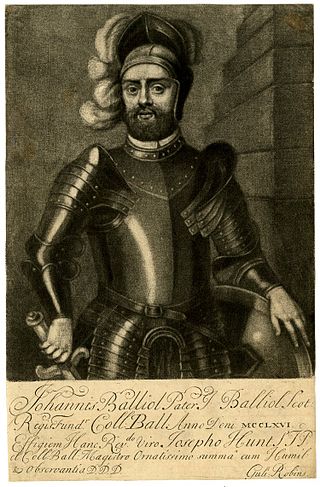
John de Balliol was an English nobleman, belonging to the House of Balliol. Balliol College, in Oxford, is named after him.
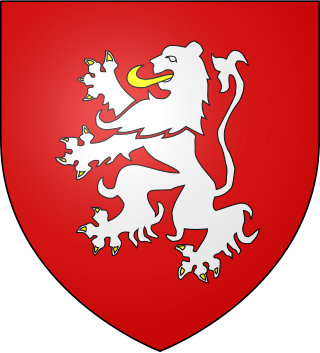
Ranulf II, 4th Earl of Chester (1099–1153), was an Anglo-Norman baron who inherited the honour of the palatine county of Chester upon the death of his father Ranulf Meschin, 3rd Earl of Chester. He was descended from the Counts of Bessin in Normandy.

Robert V de Brus, 5th Lord of Annandale, was a feudal lord, justice and constable of Scotland and England, a regent of Scotland, and a competitor for the Scottish throne in 1290/92 in the Great Cause. He is commonly known as "Robert the Competitor". His grandson Robert the Bruce eventually became King of Scots.
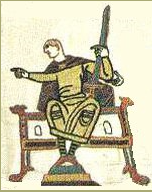
Guy I of Ponthieu was born sometime in the mid- to late 1020s and died 13 October 1100. He succeeded his brother Enguerrand as Count of Ponthieu.
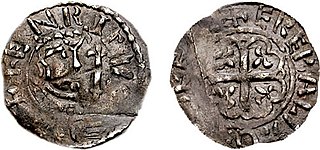
Henry of Scotland was heir apparent to the Kingdom of Alba. He was also the 3rd Earl of Northumbria and the 3rd Earl of Huntingdon. He was the son of King David I of Scotland and Queen Maud, 2nd Countess of Huntingdon.

Robert I de Brus, 1st Lord of Annandale was an early-12th-century Anglo-Norman lord and the first of the Bruce dynasty to hold lands in Scotland. A monastic patron, he is remembered as the founder of Gisborough Priory in Yorkshire, England, in present-day Redcar and Cleveland, in 1119.

The relationship between the Kingdom of England and King David I, who was King of Scotland between 1124 and 1153, was partly shaped by David's relationship with the particular King of England, and partly by David's own ambition. David had a good relationship with and was an ally of Henry I of England, the King who was largely responsible for David's early career. After Henry's death, David upheld his support for his niece, the former Empress-consort, Matilda, and expanded his power in northern England in the process, despite his defeat at the Battle of the Standard in 1138.
Guy I de Balliol was a Picard baron who was granted land in northern England in the late eleventh century. In the 1090s, he was established in the north of England by King William Rufus, as part of King William's carve-up of the forfeited earldom of Northumberland.
Guy II de Balliol was probably the second-eldest son of Bernard I de Balliol, Lord of Balliol and Barnard Castle. As his older brother Enguerrand predeceased their father, Guy succeeded when his father died sometime between 1154 and 1162. He died sometime on or before 1167, and was succeeded by his youngest brother Bernard II de Balliol.
Bernard II de Balliol was the fourth and youngest son of Bernard I de Balliol, lord of Balliol and Barnard Castle. Bernard appears to have succeeded his older brother Guy II de Balliol to the Balliol estates sometime between the early 1160s and 1167.
Eustace de Balliol was the cousin and successor of Bernard II de Balliol, lord of Balliol and Barnard Castle. He was the lord of Hélicourt in Picardy, an estate near the chief seat of the main Balliol line at Bailleul-en-Vimeu; after his cousin died childless, in 1190 Eustace de Helicourt took over those estates and remarried.

Hugh de Balliol, Lord of Bywell, Barnard Castle and Gainford, was an English nobleman. He was the son of Eustace de Balliol and Petronilla FitzPiers. Balliol was a supporter of King John of England during the Barons Wars of 1215–17.
Eustace fitz John, Constable of Chester, was a powerful magnate in northern England during the reigns of Henry I, Stephen and Henry II. From a relatively humble background in South East England, Eustace made his career serving Henry I, and was elevated by the king through marriage and office into one of the most important figures in the north of England. Eustace acquired a great deal of property in the region, controlled Bamburgh Castle, and served jointly with Walter Espec as justiciar of the North.

The siege of Wark is a 1138 siege of Wark on Tweed Castle conducted from May–November by Scottish forces under David I against the defending English garrison. The siege was part of a campaign launched by David in support of his niece, the Empress Matilda, and her claim to the English throne over that of Stephen of Blois who had seized the throne in 1135. The invasion followed a similar campaign in 1136 when David had succeeded in gaining control of Cumberland, and raids launched in 1137 and earlier in 1138.
References
- Stell, G. P., "Balliol, Bernard de (d. 1154x62)", Oxford Dictionary of National Biography, Oxford University Press, 2004 , accessed 24 Jan 2008